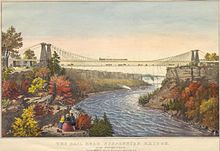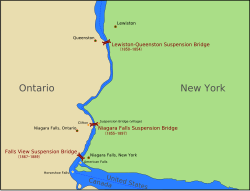Niagara Falls Suspension Bridge
| Niagara Falls Suspension Bridge | |
|---|---|

Hand-colored lithograph of the Suspension Bridge as seen from the American side; the bridge's architecture, the distant Niagara Falls, and the Maid of the Mist below the bridge are visible.
|
|
| Coordinates | 43°06′33″N 79°03′30″W / 43.109208°N 79.058336°WCoordinates: 43°06′33″N 79°03′30″W / 43.109208°N 79.058336°W |
| Carries | Trains and carriages |
| Crosses | Niagara River |
| Locale | Niagara Falls, New York and Niagara Falls, Ontario |
| Official name | International Suspension Bridge (United States) Niagara Falls Suspension Bridge (Canada) |
| Maintained by | Niagara Falls International Bridge Company (United States) Niagara Falls Suspension Bridge Company (Canada) |
| Characteristics | |
| Design | Suspension bridge |
| Material | Wood, limestone, cast iron, and wrought iron (gradually replaced with steel) |
| Longest span | 825 feet (251 m) |
| Load limit | 450 short tons (410 t; 400 long tons) |
| Clearance below | 250 ft (76 m) |
| History | |
| Designer |
Charles Ellet, Jr. (1847–48) John A. Roebling (1851–55) Leffert L. Buck (1877–86) |
| Opened | August 1, 1848 (temporary bridge) March 18, 1855 (railway) |
| Closed | 1896, dismantled by August 27, 1897, replaced by the Whirlpool Rapids Bridge |
| Statistics | |
| Daily traffic | 45 trains per day (1860) |
| Toll | 25 cents per person, 50 cents per horse-carriage, 50 cents per carriage passenger (1873) |

Map of the Niagara River, showing the suspension bridges downstream from the Falls
|
|
The Niagara Falls Suspension Bridge, which stood from 1855 to 1897 across the Niagara River, was the world's first working railway suspension bridge. It spanned 825 feet (251 m) and stood 2.5 miles (4.0 km) downstream of Niagara Falls, where it connected Niagara Falls, Ontario, to Niagara Falls, New York. Trains used the upper of its two decks, pedestrians and carriages the lower. The brainchild of Canadian politicians, the bridge was built by one American and one Canadian company. It was most commonly called the Suspension Bridge; other names included Niagara Railway Suspension Bridge, Niagara Suspension Bridge, and its official American name, the International Suspension Bridge.
The bridge was part of Canadian politician William Hamilton Merritt's vision to promote trade within his country and with its neighbor the United States. Many, including bridge builders, argued that a suspension bridge could not allow the safe passage of trains. Nonetheless, the bridge companies hired Charles Ellet, Jr., who laid a line by a kite across the 800-foot (240 m) chasm and built a temporary suspension bridge in 1848. Ellet left the project after a financial dispute with the bridge companies, who hired John Augustus Roebling to complete the project. By 1854, his bridge was nearly complete, and the lower deck was opened for pedestrian and carriage travel. On March 18, 1855, a fully laden passenger train officially opened the completed bridge.
A border crossing between Canada and the United States, the Suspension Bridge played significant roles in the histories of the Niagara region and the two countries. Three railway lines crossed over the bridge, connecting cities on both sides of the border. The Great Western Railway, New York Central Railroad, and New York and Erie Rail Road differed in the track gauge; the bridge used a triple gauge system to conserve space, overlapping two tracks on top of each other and using a rail of each to form the third track. The railroads brought a large influx of trade and tourists into the region around the Niagara Falls. In the time leading to the American Civil War, the Underground Railroad helped slaves in the United States escape across the Suspension Bridge to freedom in Canada. After the war, the bridge became a symbol of inspiration to Americans, encouraging them to rebuild their country and pushing them to quickly industrialize their nation.
...
Wikipedia
